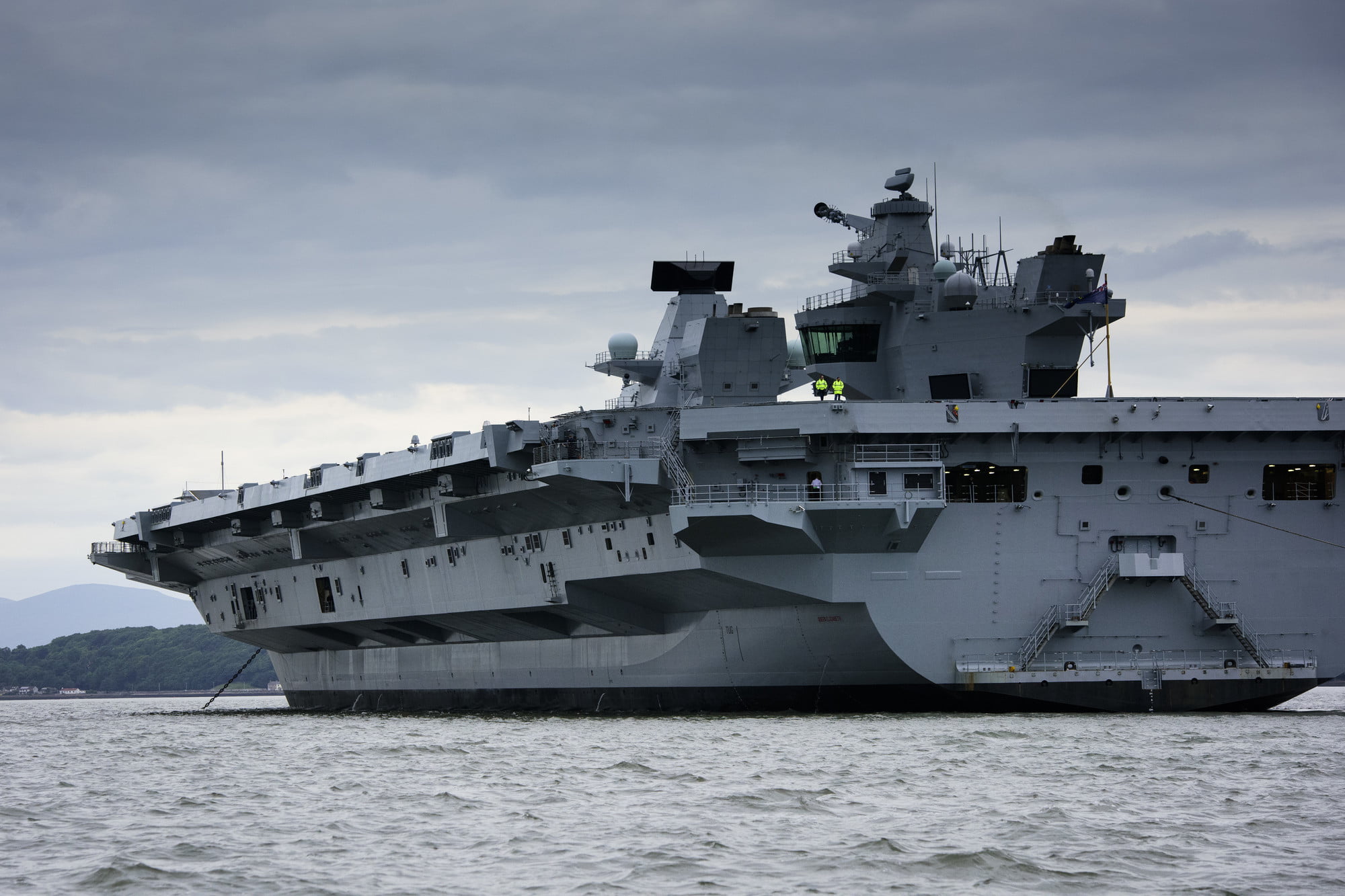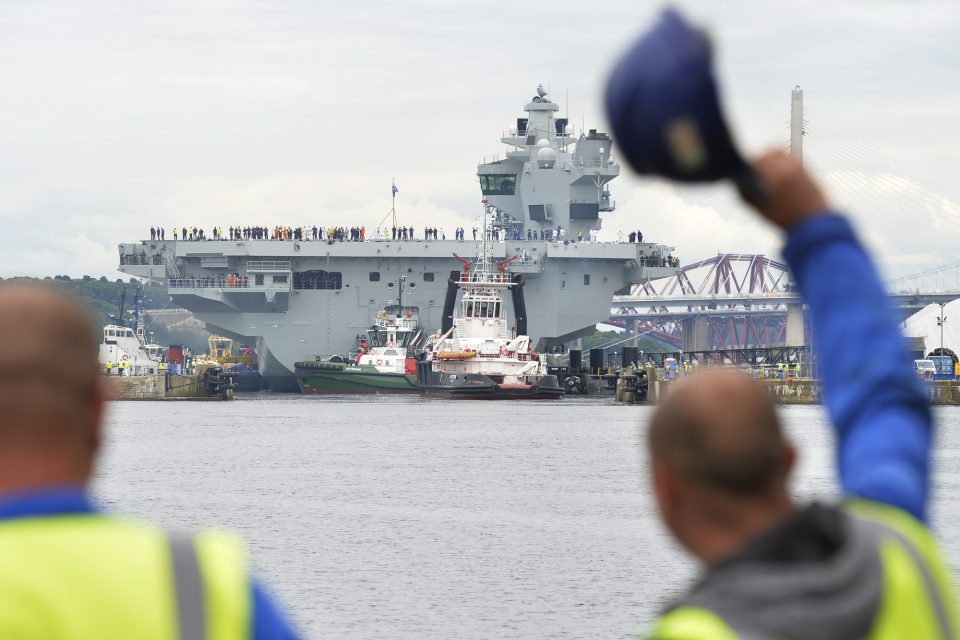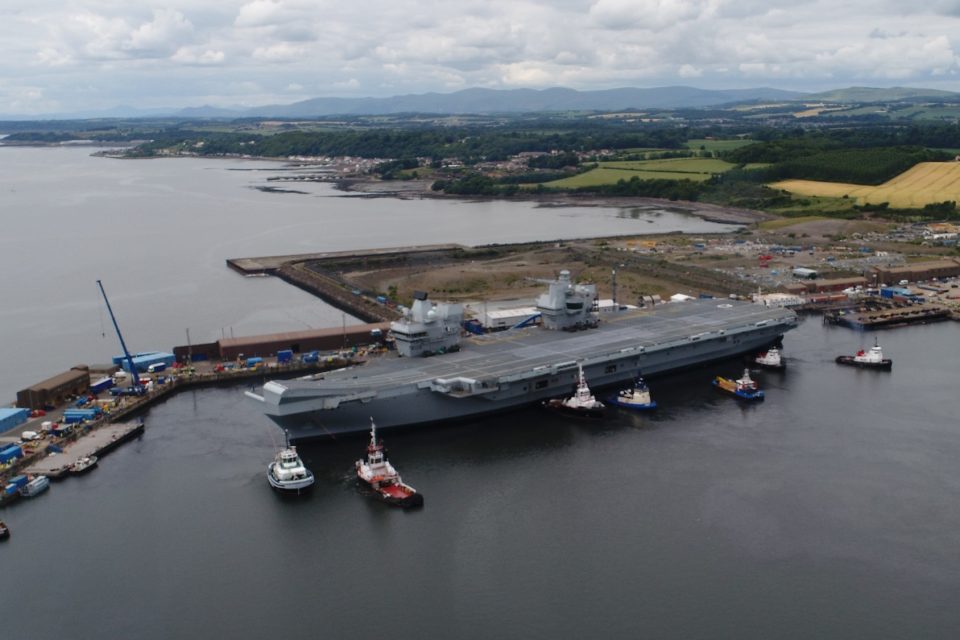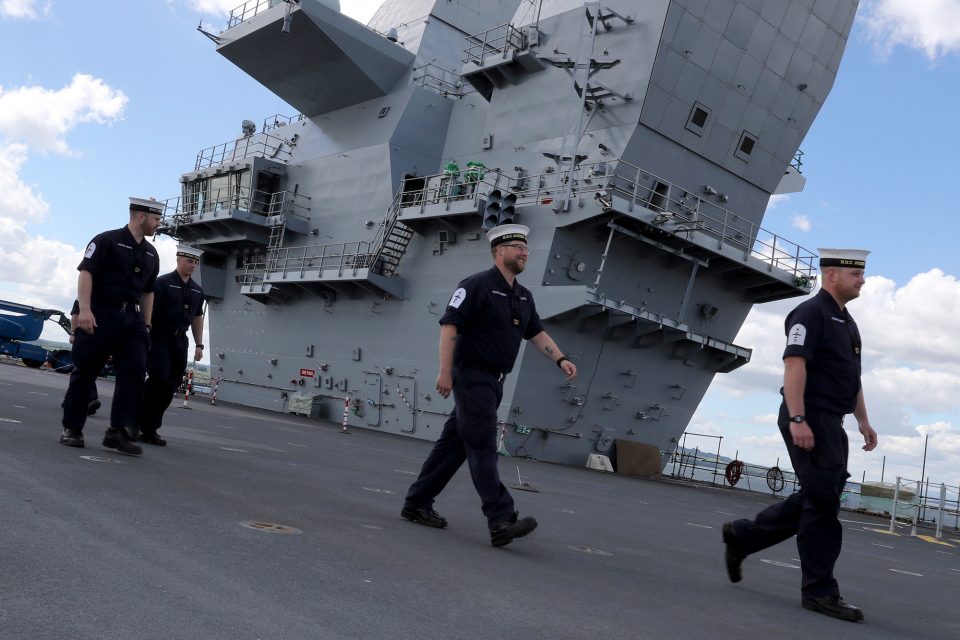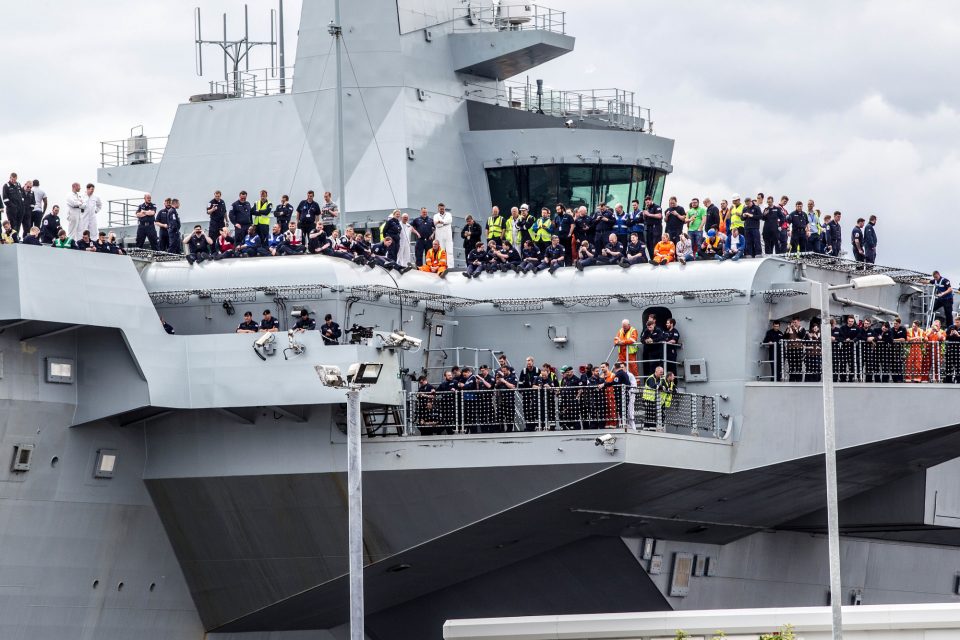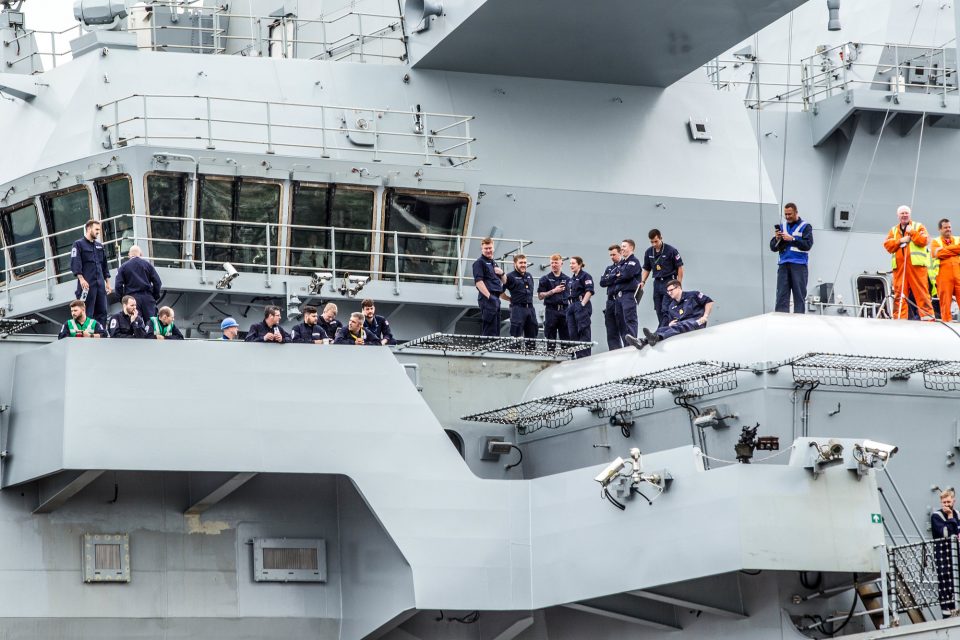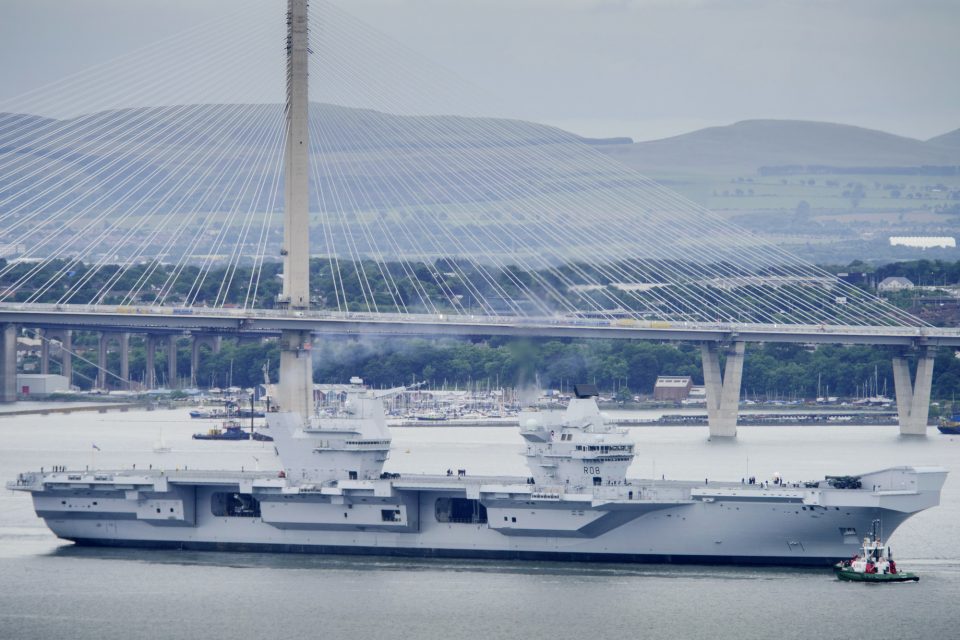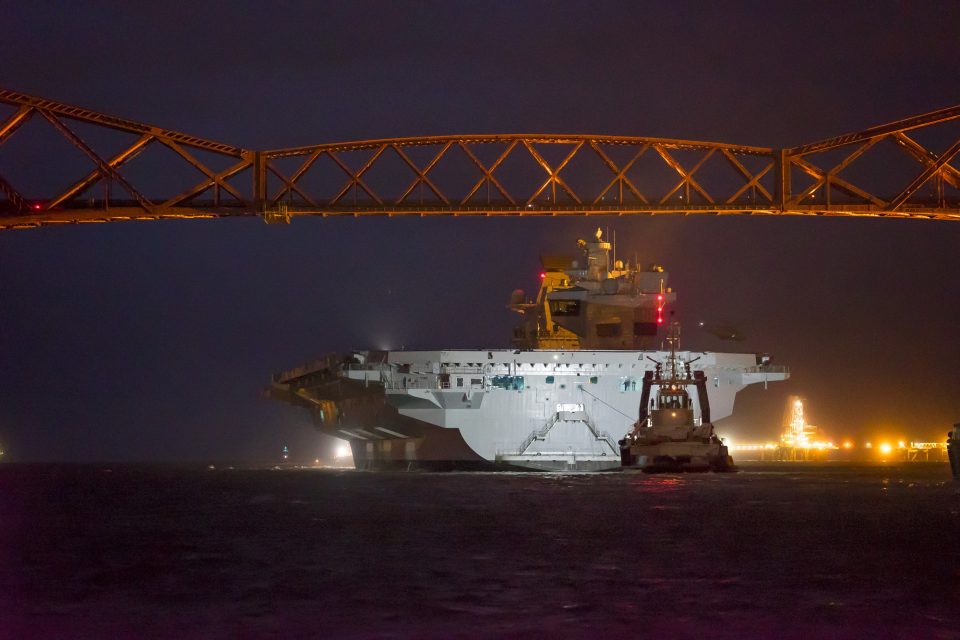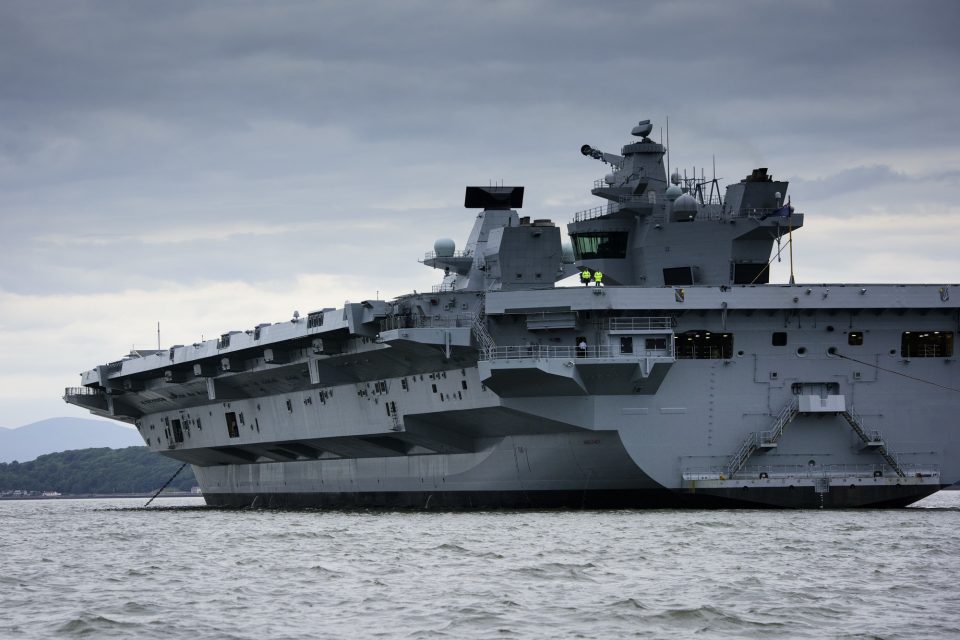2017-06-28 Second Line of Defense has visited the Queen Elizabeth while it was being built in Scotland as well as various F-35B facilitates in the US and the UK preparing for the integration of the fifth generation aircraft with a new generation carrier.
Now for the first time, the new carrier has gone to sea.
According to an article published June 26, 2017 on the UK Ministry of Defence website, “the first QE Class aircraft carrier, set sail from Rosyth to commence first stage sea trials off the north-east of Scotland.”
Defence Secretary Sir Michael Fallon said:
“This is a historic moment for the UK as our new aircraft carrier takes to sea for the very first time. This floating fortress is by far the most powerful ship ever built in Britain that will enable us to tackle multiple and changing threats across the globe.
“HMS Queen Elizabeth is an enduring example of British imagination, ingenuity, invention that will help keep us safe for decades to come. She is built by the best, crewed by the best and will deliver for Britain.
“For the next fifty years she will deploy around the world, demonstrating British power and our commitment to confronting the emerging challenges from a dangerous world. The whole country can be proud of this national achievement.”
Timelapse Video of Queen Elizabeth Transiting to Sea for the First Time from SldInfo.com on Vimeo.
Three years after she was officially named by Her Majesty The Queen, the Nation’s future flagship will spend an initial period of around six weeks at sea to test the fundamentals of the ship. The sea trials will monitor speed, manoeuvrability, power and propulsion as well as undertaking weapons trials and additional tests on her levels of readiness.
Following this initial period, HMS Queen Elizabeth will return to Rosyth for further testing and maintenance before heading back to sea for a second stage which aims to test her Mission Systems. She will transit to her home port of Portsmouth Naval Base to be handed over to the Royal Navy later this year.
Admiral Sir Philip Jones First Sea Lord and Chief of Naval Staff said:
“This is a hugely significant moment for the Royal Navy, for all our Armed Forces and for our island nation. Once in service HMS Queen Elizabeth will be the largest aircraft carrier in the world outside the United States, and the first designed from the outset to operate a fifth generation aircraft.
“Already this ship represents the best of the UK’s industrial and engineering expertise, and once in service she will symbolise our military power and authority in the world for decades to come. There is still much work to do between now and then, but be in no doubt: a new era of British maritime power is about to begin.”
HMS Queen Elizabeth is the largest and most powerful warship ever constructed for the Royal Navy. The ship will operate with a crew of approximately 700, increasing to the full complement of 1,600 when aircraft are in operation. The Ship’s Company moved on board earlier this month. Working alongside industry colleagues, they have been familiarising themselves with the new ship and the high tech systems on board as well as undergoing training.
Jon Pearson, Ship Delivery Director HMS QUEEN ELIZABETH said:
“The QE Class programme demonstrates our pride and commitment to deliver these highly capable aircraft carriers to the Royal Navy.
“The departure of HMS Queen Elizabeth marks an exciting stage in the programme and is the first real opportunity to put the carrier’s outstanding capability to the test, demonstrating the best of British engineering and manufacturing.”
HMS Queen Elizabeth’s sister ship, HMS Prince of Wales is structurally complete and is currently in the outfitting phase of her programme. The Class will be the centrepiece of Britain’s maritime capability. Each aircraft carrier, coupled with the F-35B Lightning aircraft, will form an integral part of the UK’s Carrier Strike capability. The vessels will transform the UK’s ability to project power around the World, whether independently or working closely with our allies, on operations ranging from high intensity warfighting to providing humanitarian aid and disaster relief.
The aircraft carriers HMS QUEEN ELIZABETH and HMS PRINCE OF WALES are being delivered by the Aircraft Carrier Alliance, a unique partnering relationship between BAE Systems, Thales UK, Babcock and the Ministry of Defence.
A national endeavour, at its peak the programme directly employed 10,000 people across six build yards. While manufacturing and commissioning is now solely focused in Rosyth, the skilled and diverse workforce is sourced from across the country.
Queen Elizabeth Prepares to Go to the Sea for the First time from SldInfo.com on Vimeo.
Key Facts
- Each carrier weighs 65,000 tonnes
- Each carrier is 280 metres in length
- Top speed is upwards of 25 knots
- The carriers will have a crew complement of c.700, increasing to c.1,600 when a full complement of 36 F-35B aircraft and four Crowsnest helicopters are embarked
- The flight deck is 70 metres wide and 280 metres long – enough space for three football pitches
- Each carrier keeps 45 days’ worth of food in its stores.
- Each carrier is made up of 17 million parts
- There are 364,000 metres of pipes inside each of the Ships
- 51 million hours have been spent designing and building the Queen Elizabeth Class.
- The entire Ship’s Company can be served a meal within 90 minutes, 45 minutes when at action station
- The QE Class aircraft carriers are the first Royal Navy vessels to have piped oxygen within the medical complex
Key efficiencies include:
- Highly mechanised weapons handling system: At the push of a button pallets of munitions can be moved from the magazines deep in the weapons preparation area to the flight deck where they can be loaded onto aircraft.
- Storage: The location and design of the storage facilities enable 20 people only half a day to replenish the ship’s stores.
- Visual surveillance system: 220 cameras allow monitoring of engine and machinery spaces, external catwalk, aircraft hangars, ship entrances and access to classified areas.
- Galley: Technologically advanced equipment and layout of the galley makes maintenance and service more efficient. The entire crew can be served meals in 90 minutes and 45 minute when at action stations.
And Colin Clark of Breaking Defense reported on the carrier at the recent Paris Air Show.
PARIS AIR SHOW: First it was cyber. Now I find myself covering ships at an air show.
Ok. They are aircraft carriers so I guess we can give the Queen Elizabeth carriers a pass.
The big news here?
The first of the two ships should sail for the first time later this month, or maybe next month — depending on the weather and the tides.
That was the word from Rear Adm. Keith Blount of the Royal Navy who came here for a visit of several hours, much of which he spent with the press.
Why did he spend so much time with the dreaded media at an air show?
Probably because the main combat power of the ship (aside from SAS, Royal Marines and anti-submarine helicopters) will derive from the 36 F-35Bs the QE class can carry into battle.
Among the QE class’ most intriguing characteristics will be its completely clear and uncluttered flight deck which will allow a large number of helicopters to be stationed ready for takeoff or a large number of F-35s.
Since the QE class was reportedly built from the start with an eye to putting Special Air Service and Royal Marines directly into harm’s way, supported by Merlin helicopters and F-35Bs, there’s an obvious logic to this deck.
And Blount told reporters the carriers would carry a Royal Marine Special Purpose Task Group of indeterminate size on every mission.
In addition, they will sail with the best Combat Search and Rescue (CSAR) capabilities they can carry, given whatever other missions they’ve got, Blount told us. One of the more likely aircraft to be added to the ship to support these is some version of the V-22.
There have been persistent rumors that Britain wants to buy some, but nothing definitive has been said publicly.
And that’s why we’re talking about ships at the air show.
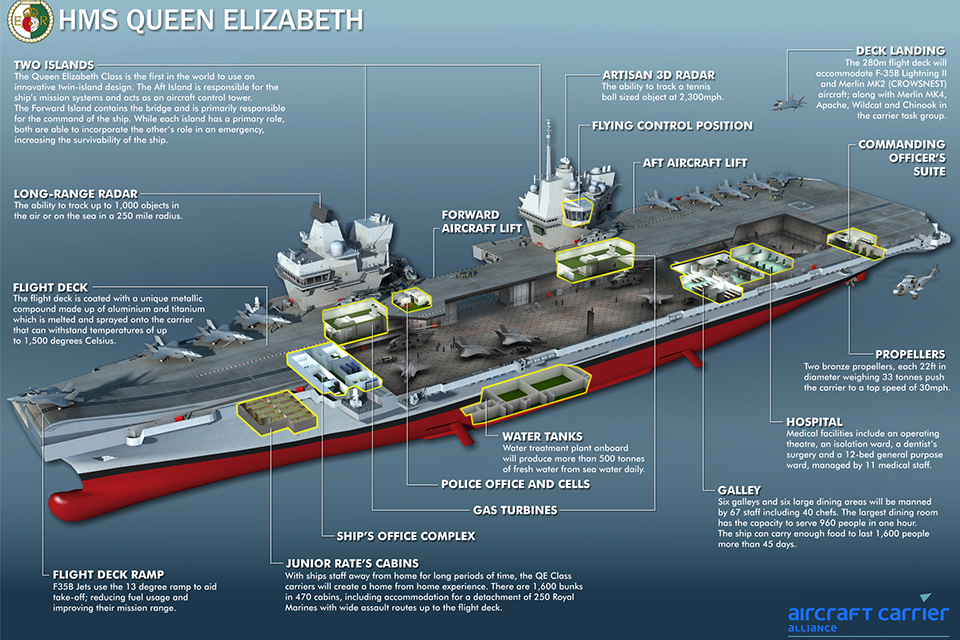 Computer Generated 3/4 Image of HMS Queen Elizabeth.
Computer Generated 3/4 Image of HMS Queen Elizabeth.
The QE Class aircraft carrier are biggest warships ever built for the Royal Navy – four acres of sovereign territory, deployable across the globe to serve the United Kingdom on operations for 50 years. HMS Queen Elizabeth and HMS Prince of Wales will be the most advanced warships in the Royal Navy fleet.
The photos in the slideshow and the videos are credited to BAE Systems.
And in an article published two years ago, we wrote about the three Western new carrier programs.
2015-06-03 By Robbin Laird
As published by our partner India Strategic
http://www.indiastrategic.in/topstories3766_A_Tale_of_Three_Carriers.htm
Newport News, Pascagoula, Mississippi, and Rosyth Scotland.
In the famous opening lines of Charles Dickens Tale of Two Cities, he noted that “it was the best of times; it was the worst of times.”
So it is for aircraft carriers.
The critics of aircraft carriers focus on their vulnerability and the rise of capabilities such as the DF-21 Chinese “carrier killer” missiles; yet new carriers are emerging tailored for 21st century operations.
It is clear that the USN, the USMC, the Royal Air Force and the Royal Navy are all pursuing new carrier programmes designed to thrive, not just survive in 21st century operations.
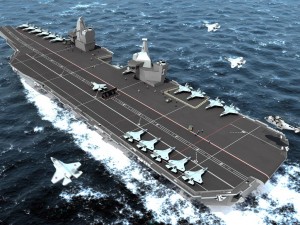
I have had the rare opportunity to be aboard all three of the new carriers: the 52,000-ton USS America, which is the amphibious assault ship ever built; the 100,000-ton CVN-78 or the USS Gerald Ford, and the 65,000 ton HMS Queen Elizabeth.
The ships have several 21st century technologies in common: the construction of vastly improved command and control (C2) capabilities, working in sync with networked forces in a distributed operational environment.
The ships will have a 40 plus service life (although combat has its own logic), and will host significant transformation with regard to the combat assets carried aboard.
But each ship is built around significant airpower modernisation.
The USS America will host the Ospreys (including refueling Ospreys), F-35Bs, and the CH-53K (which can carry externally three times the load of the CH-53E); CVN-78 will see the new Hawkeye, the F-35C, and UCAS aboard her; and the HMS Queen Elizabeth is built around the F-35B as well as new airborne command capabilities.
And the Ford and the Queen Elizabeth have advanced electric power generation capabilities to take on board directed energy weapons as those capabilities evolve. Both ships have significant connectivity, with miles of fibre-optic cables, and reconfigurable C2 workstations to allow for operations against the ROMO (Range of Military Operations).
Aircraft Carriers are very good for a spectrum of operations, both in securing strategic interests through deterrence and war fighting capabilities but also for humanitarian assistance and disaster relief.
The three carriers mentioned have sufficient flexibility in this perspective.
They also ensure logistical integrity permitting operations from the sea without having to set up land bases.
Their air power allows them to leverage their strike capabilities for subsurface, surface, landbased and even aerial or space assets.
It was from a ship that the US shot down a satellite using a Raytheon missile. Each ship though is unique. But each one has the flexibility to adapt to the varied requirements as they arise.
USS America: Reinventing Amphibious Assault
The USS America is the largest amphibious ship ever built by the United States.
The ship has been built at the Huntington Ingalls shipyard in Pascagoula, Mississippi and departed mid-July 2014 for its trip to its initial home port at San Diego, California and then was commissioned in San Francisco in mid-October 2014. It is now undergoing its final trials and preparing to enter the fleet.
The USMC is the only tilt rotor-enabled assault force in the world.
The USS America has been built to facilitate this capability and will be augmented as the F-35B is added to the Ospreys, and helicopters already operating from the ship. Later, unmanned aircraft will also become a regular operational element.
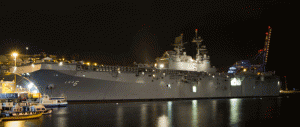
The Boeing-Bell Osprey has obviously been a game changer, where today, the basic three ship formation used by the Amphibious Ready Group-Marine Expeditionary Unit can “disaggregate” and operate over a three-ship distributed 1,000-mile operational area.
Having the communications and ISR to operate over a greater area, and to have sustainment for a disaggregated fleet is a major challenge facing the future of the USN-USMC team. The combination of Ospreys and F-35 B will be deadly for any foe.
A major change in the ship can be seen below the flight deck, and these changes are what allow the assault force enabled by new USMC aviation capabilities to operate at greater range and ops tempo. The ship has three synergistic decks, which work together to support flight deck operations.
Unlike a traditional large deck amphibious ship where maintenance has to be done topside, maintenance is done in a hangar deck below the flight deck. And below that deck is the intermediate area, where large workspaces exist to support operations with weapons, logistics and sustainment activities.
The ship can hold more than 20 F-35Bs. The Ospreys would be used to carry fuel and or weapons, so that the F-35B can move to the mission and operate in a distributed base. This is what the Marines refer to as shaping distributed STOVL ops for the F-35B within which a sea base is a key lily pad from which the plane could operate or move from.
Alternatively, the F-35B could operate for ISR (Intelligence, Surveillance and Reconnaissance). Understandably, all US assets area already networked through satellites.
The other new onboard asset is Sikorsky’s CH-53K, which will be backbone for an airborne amphibious strike force. It will be able to carry three times the load external to itself than can a CH-53E and has many operational improvements, such as a fly-by-wire system.
These elements constitute a true enabler for a 21st century amphibious assault force.
CVN-78: Redefining the Large-Deck Carrier
The coming of the USS Gerald R. Ford sets in motion a very different type of large-deck carrier. The hull form of the Ford is a tribute to the very successful Nimitz-class hull design. But that is where the comparisons end.
In effect, the new nuclear-powered carrier provides infrastructure for – significantly – the US Navy as well as its coalition forces.
It is designed to operate more effectively with an evolving air wing over its 50-year life span. The high increase in electric power generation, three times greater than Nimitz, is designed to allow the electronic systems associated with defense, attack and C2 to grow over time.
The carrier’s new launch and recovery systems (EMALS – Electromagnetic Aircraft Launch System and AAG- Advanced Arresting Gear), the weapons handling system and many other improvements are visible signs of new capabilities.
The onboard super computers manage everything from electric power to fire power, and give outstanding support to the crew. Laser weapons will be a reality on Gerald Ford.
The next generation in active sensor technology, with great bandwidth in the dual band radars, provides a solid foundation, not simply for the organic defence and strike capability of the carrier but for the entire battle fleet.
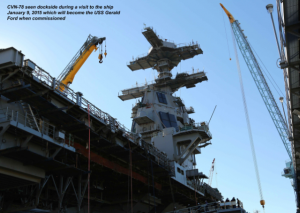
In a recent interview Captain John Meier, the designated skipper of CVN-78, highlighted a number of innovations, two of which are the new launch system and the second is the new weaponisation systems and pit stop approach to operating aircraft.
The first involves the shift from steam catapults to an electronic system or EMALS. “The EMALS system will allow us to provide for an ability to launch aircraft more smoothly and with less wear and tear on the airplanes and the pilots. Coupled with the new advanced arresting gear, we will be able to launch and recover a variety of types of aircraft, including future designs that haven’t been developed.”
As for directed energy systems, he observed: “You have a great capacity for diversity of weapons, and the advanced weapon elevators themselves are located on the ship to facilitate faster movement and loading of the weapons.
That’s the underlying principle of the advanced weapon elevators. They carry more weight and they go faster, twice the speed and twice the weight essentially of the legacy weapons elevators” bringing ordnance right near an aircraft for loading.
Combat jets will be loaded in “pit stops” aboard the deck and then launched from the EMALS system.
And with the coming of the F-35 C, the head of Naval Air Warfare, Rear Admiral Manazir noted in an interview done after the visit to the Ford:
“Reach not range is a key aspect of looking at the carrier air wing and its ability to work with joint and coalition forces.
This is clearly enhanced with the F-35.The carrier has a core ability to operate organically but its real impact comes from its synergy with the joint and coalition force, which will only go up as the global F-35 fleet emerges.
And this will get better with the coming of the USS Ford. What the Ford does is it optimises the things that we think are the most important.”
HMS Queen Elizabeth: Reinventing the Large Deck Carrier
The Brits invented carrier warfare; and in many ways with their new 65,000-ton carrier they are reinventing the large deck carrier and providing something of a hybrid between the USS America and CVN-78.
The flight deck is impressive and is about 90 per cent of the size of the Nimitz class and has a very wide deck.
When I stood at the end of the ski jump and looked down at the flight deck, its width was significant.
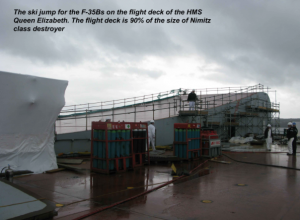
And I learned that the flight deck was built by Laird Shipbuilding (unfortunately no relation!).
This ship is designed to operate F-35Bs, which means that the RAF (Royal Air Force) and RN (Royal Navy) will drive every bit of innovation out of the aircraft to provide C2, ISR and strike capabilities.
There will be natural interoperability between the US and British forces, right from training to operations.
Walking the ship takes time, but several innovations one sees aboard the Ford can be found aboard the HMS Queen Elizabeth: significant energy generation, significant C2 capabilities, very large rooms for reconfigurable C2 suites for operations across the ROMO, as well as well designed work areas for the F-35B crews which will handle the operations and data generated by the F-35 to the fleet.
It is a ship designed to transform both the RAF and the RN for it will integrate significantly with the surface and subsurface fleet and the land-based air for the RAF.
To take an example, with RAF jets operating from Cyprus or in the Middle East, the HMS Queen Elizabeth can mesh its air assets with the land based assets and the command centre directing the air operations could be on the ship, on land at an operating base, or in the air, even in the new tankers.
Conclusion
Despite the critics, new carriers are being designed and built to work more effectively in an integrated operational space to provide both defence and offence to a joint and coalition force.
They are key elements of the distributed force, one which is forging a 21st century approach to offense-defense enterprise across the spectrum of military operations.
The author would like to thank Ed Timperlake for his contribution to the thinking underlying this article


